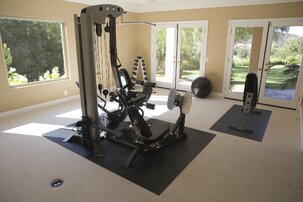Release time:2022-05-13
Strong is the new skinny.
Preserving lean muscle mass while losing weight isn’t always easy. Still, it’s super important to overall health and wellness, as well as to aiding your weight loss efforts.
Lean muscle supports your strength, energy levels, mobility, heart and metabolic health. It's linked to a longer life span and has a major influence over the rate at which you burn calories.
The problem is that most of the time, when people succeed at their weight-loss goals, they wind up losing muscle. Michal Mor, co-founder, head of science and chief of product at Lumen, a Tel Aviv based company aiming to bring metabolic health products to the general public, says “when we lose weight, we tend to lose muscle tissues, which means we unfortunately burn fewer calories.”
This can slow your basal metabolic rate and make it even more difficult to lose weight.

1. Keep your caloric deficit small.
With caloric deficits driving weight loss and surpluses stimulating muscle gain, a happy medium is ideal for "recompositioning," or decreasing body fat while increasing lean muscle mass.
For instance, in one 2016 Obesity study, when people drastically cut calories for 12 weeks, they lost 8.8% of their total-body muscle. When people cut conservatively, they only lost 1.3% of their muscle.
The smaller your caloric deficit, the less muscle will break down as you lose weight – and the greater your likelihood of being able to actively build muscle, explains Jim White, registered dietitian, exercise physiologist and owner of Jim White Fitness & Nutrition Studios in Virginia. Previous research shows that people who exercise can build substantial muscle if they keep a very small caloric deficit.
White says your goal should be to lose no more than 1 to 2 pounds per week. While every person will need to cut calories and/or increase their activity levels slightly differently to lose weight at this rate, reducing caloric intake by 500 calories per day is a good place to start – over the course of seven days, those 500 calories add up to 3,500 or 1 pound. To make greater muscle gains, cut even fewer calories.

2. Be patient.
Being patient might be the hardest tip of all, but it's important to keep in mind. That's because, while you may notice yourself making great gains to start with, they will naturally slow over time.
"It becomes progressively more difficult to increase muscle while losing fat as you become more trained and get leaner," says researcher Brad Schoenfeld, a certified strength and conditioning specialist and associate professor of exercise science at Lehman College in the Bronx, New York.
It's just how the human body works: The more excess fat you have to lose, the easier it is to lose 5 pounds of fat. (This is especially true when maintaining a very small caloric deficit.)
The more muscle you have to gain, the easier it is to gain 5 pounds of muscle. As you get closer to your goal, expect to see more subtle changes in your fat and muscle levels. Remember not to get discouraged.

3. Eat 25-plus grams of protein four times per day.
“We’ve all heard the cliché, ‘abs are made in the kitchen.’ It’s so true,” says Thomas Roe, an American Council on Exercise certified personal trainer, endurance athlete, founder of TRoe Fitness and owner of Local Moves Studio in San Antonio, Texas.
Following a strict nutrition plan that’s high in lean protein (chicken and turkey breast, fish, tofu and tempeh are good examples) while doing the right kind of exercises can help maintain muscle.
That’s because your muscles use the protein you eat to grow bigger or stronger. When cutting calories, your body's muscles may be less sensitive to the protein you eat, Spano says.
Hence why, in one study published in the American Journal of Clinical Nutrition, when exercising men followed a low-calorie diet that was high in protein for four weeks, they lost 10.56 pounds of fat while gaining 2.64 pounds of lean muscle. Meanwhile, those who followed a diet with the same amount of calories, but less protein, only lost 7.7 pounds of fat and gained less than a quarter pound of muscle.
"In addition, this protein intake should be spaced out evenly throughout the day," Spano says. This keeps your muscles fed with a steady stream of building blocks.
In fact, a 2018 review in the Journal of the International Society of Sports Nutrition concluded that for optimal muscle growth, people should consume between 0.2 and 0.25 grams of protein per pound of their body weight four times per day.
For a 180-pound adult, that equals four meals of 33 to 45 grams of protein. Other research recommends 25 to 35 grams of protein at every meal for most adults – and slightly more for vegetarians and vegans.

4. Consider trying intermittent fasting.
Mor recommends intermittent fasting as a strategy that has been shown to help people preserve and gain muscle mass while losing weight. Intermittent fasting can help support metabolic rate and metabolic flexibility, she says. Metabolic flexibility means your body is able to efficiently switch between burning both carbs and fat as fuel.
“This relates to muscle building and weight loss because if you’re able to burn through carbs efficiently during a workout, you can lose weight more efficiently since you’ll then be burning through fat stores,” she says.
Combining weight training with intermittent fasting can help activate that process, she says. “Combining strength training with intermittent fasting is a great way to burn through leftover carb stores overnight and increase your chances of waking up burning fat in the morning,” she says.

5. Do compound strength exercises at least three times per week.
"You need to include at least two days of weight training a week to maintain existing muscle mass and three or more times a week to build muscle," White says. And in one Harvard School of Public Health study of 10,500 adults, researchers found that strength training doesn't just build muscle – it also helps reduce abdominal fat levels.
The most effective exercises, for both fat loss and muscle gain, are compound – meaning they work multiple muscle groups at once. Examples include squats, chest presses and rows.
Focus on making these moves the top priority of your weekly workout routine, and then you can start to think about adding the right cardio workouts to your routine.

6. Use cardio for recovery.
Cardio isn't the most effective way to build (or maintain) muscle when you're in a caloric deficit. However, it's a great tool to help you recover from your strength-training workouts so that, in the end, you maintain and build the most muscle possible.
Low-intensity cardio like walking, jogging and gentle cycling or swimming increase blood flow through the body to get oxygen and other nutrients to your muscle cells, explains Dean Somerset, an Alberta-based kinesiologist.
Roe recommends adding 35 to 45 minutes of cardio a few times a week. Stick to low-intensity workouts, with your effort feeling no more difficult than a 7 on a scale from 1 to 10.
He also encourages “drinking at least a gallon of water per day” to support your efforts for fat loss and muscle gain. However, the National Academies of Science, Engineering and Medicine say adequate daily fluid intake is about 15.5 cups daily for men and about 11.5 cups daily for women.

7. Adjust your exercise program’s structure.
Dr. James Suchy, a sports medicine physician with Hoag Orthopedic Institute in Southern California, says “the way in which an exercise program is structured can impact the outcome of your training,” meaning that if you adjust the number of sets, repetitions or the amount of rest in between them, that can affect the type of physical gains you’ll see.
For example, to increase muscle size and definition, Suchy says you should “lift the maximum weight you can lift for 6 to 12 repetitions paired with a rest period of 1 to 2 minutes between sets. This is a good entry point for those new to weightlifting and will still provide significant strength and endurance gains.”
By contrast, if you’re looking to increase muscle strength, Suchy recommends lifting the maximum weight you can lift for 1 to 6 repetitions paired with a rest period of 2 to 3 minutes between sets. “This requires more experience with weightlifting to avoid injury from poor technique,” he cautions, so it’s best to work with a trainer or coach when you begin this type of training.
If your goal is to increase muscle endurance, “lift the maximum weight you can lift for 12 to 20 repetitions, paired with a rest period of 30 to 90 seconds between sets,” Suchy says. “This may be useful for someone who doesn’t want to increase muscle mass or size.”

8. Do HIIT sparingly.
As a last add-in to your workout plan, try high-intensity interval exercises such as repeated sprints on the treadmill, elliptical or bike.
These workouts can help burn calories and reduce body fat while still building muscle, White says. However, you're best served using them only on occasion, like once or twice per week. Strength training should still be your workout focus, and overdoing it on high-intensity cardio can overstress your muscles – making them much less likely to grow.
Perform HIIT on nonconsecutive days and when you're feeling well rested.

9. Get enough rest and recovery.
“Building muscle in the gym starts with placing sufficiently challenging stress on muscle fibers during a workout,” Suchy says. But you can overdo it. “For muscle gains and fat loss to occur, adequate recovery is also essential.”
This means that “getting restful, deep sleep every night is critical.” For the average adult, 7 to 9 hours should be the goal, “with a preference towards the high end if you are exercising on a regular basis,” Suchy says.
That’s not always easy, though. “High levels of stress at work and in your personal life can detrimentally impact your recovery and capacity to come back strong for your next workout.” But, Suchy adds that “stress relieving activities like deep breathing or meditation have been shown to help.”
The bottom line
Yes, you can gain muscle while losing weight. Focus on both fueling and training your muscles while keeping your caloric deficit small. Make sustainable changes that you can stick with over the long term – both fat loss and muscle gain take time.
“I can’t stress enough that we are what we eat,” Roe adds. “Wasted calories on high sugar, processed foods, dairy and alcohol are a sure-fire way to derail your goals from putting on muscle mass and leaning out.”

